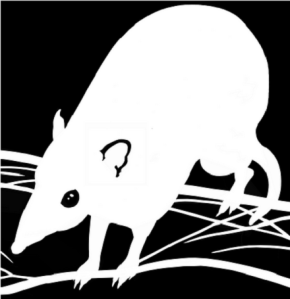By Stuart Dawson. As humans, we follow linear clearings all day. Every road, footpath, and hallway is a clearly defined, linear opening that allows us to move easily, quickly, and (excluding some beautiful European cities) reduces the likelihood of becoming lost.
When these roads and tracks are within undisturbed vegetation, such as across much of northern and central Australia, they can also influence movements of animals. Roads can be barriers to dispersal of small species, and create habitat fragmentation for these animals. But roads can also facilitate animal movements. For example, roads may be used as mobility corridors by generalist predators such as dogs and foxes, leading to the common use of sand plots on roads as a tool for measuring predator activity.

We used a paired camera trap array to investigate the use of exploration tracks (seismic lines), by a vulnerable marsupial, the greater bilby (Macrotis lagotis), and their predators: feral cats (Felis catus) and dingoes (Canis familiaris). We conducted four surveys are different sites, between 1 month and 4 years after clearing. At each site, at least 34 cameras were deployed, in pairs, with one camera of each pair set on a track, and the other placed 30 m away in the undisturbed vegetation.


We found that bilbies, feral cats and dingoes were more often recorded on tracks than off them. Importantly, preference for these tracks did not decline as the vegetation on the track recovered. This was probably because cattle also used the tracks, usually following the same paths routinely, and their movements prevented vegetation re-growth. This meant that the tracks were kept open enough to function as a mobility corridor long after the initial clearing.
If bilbies and predator species are both using tracks to move across the landscape, the chance of these species encountering one another may be artificially increased by the presence of these tracks, which could lead to an increase in predation risk for the bilbies.

We also investigated the times of day that each species was using the tracks. On tracks and in the undisturbed vegetation, bilbies were most active at around 3 am.
Dingoes were most active at sunrise.
Feral cats were most active at sunset. However, on tracks, and only on tracks, cats also showed a second peak in activity at 3 am, the exact time when bilbies were most active. This may represent cats targeting bilbies in places where they are common, at times when they are most active. We don’t have the data to explore whether this temporal overlap has any impact on the long term viability of bilby populations in areas where these tracks are cleared, or if the shift in cat activity has any impact on the predation pressure experienced by bilbies.

This research was published in Austral Ecology earlier this year, and was awarded the 2018 Mike Bull Award for best student-led paper in Austral Ecology.
Dawson, Stuart J., Adams, Peter J., Moseby, Katherine E., Waddington, Kris I., Kobryn, Halina T., Bateman, Philip W., Fleming, Patricia A., (2018). “Peak hour in the bush: linear anthropogenic clearings funnel predator and prey species.” Austral Ecology 43: 159-171 PDF.
